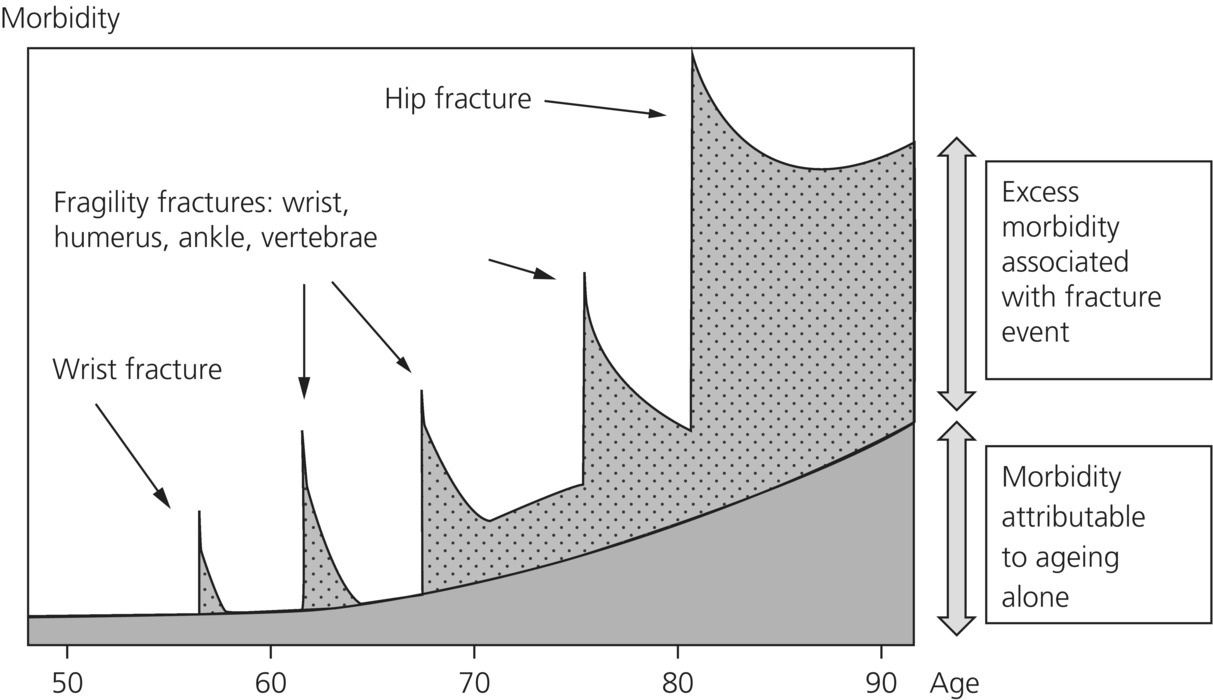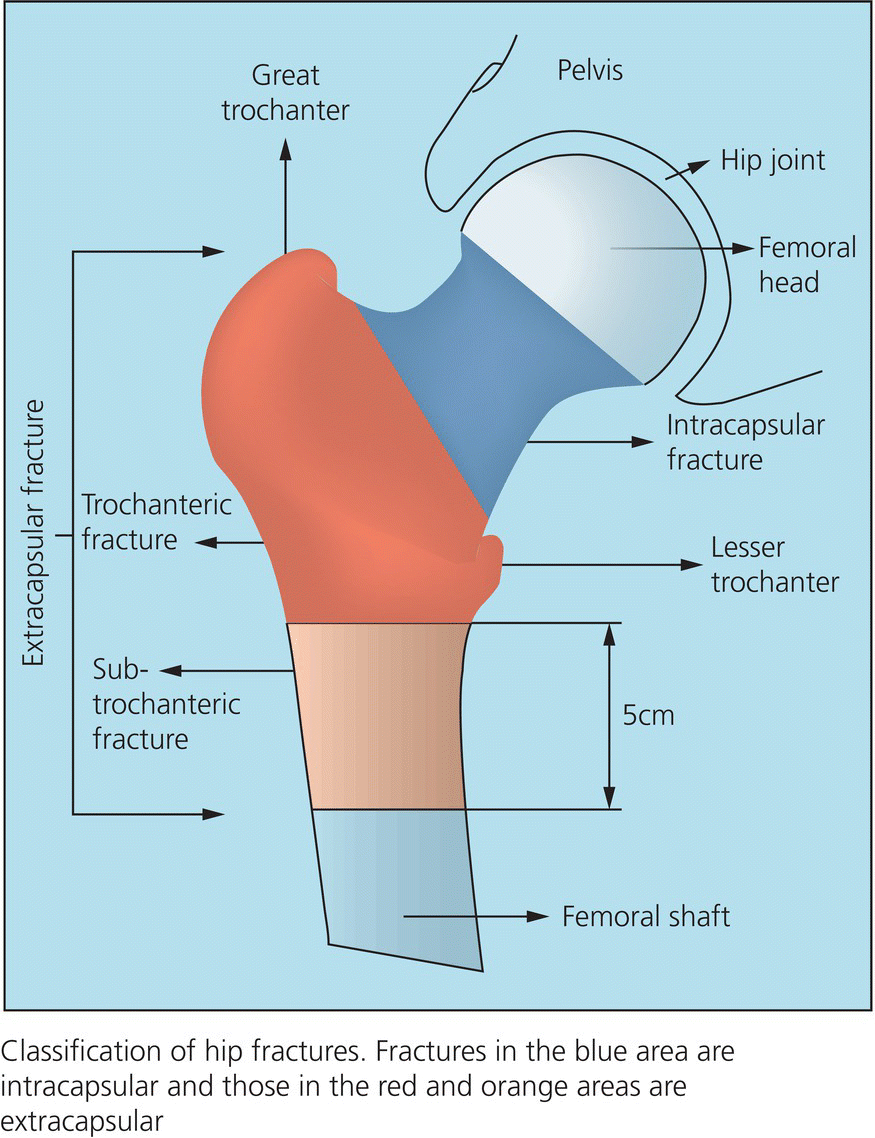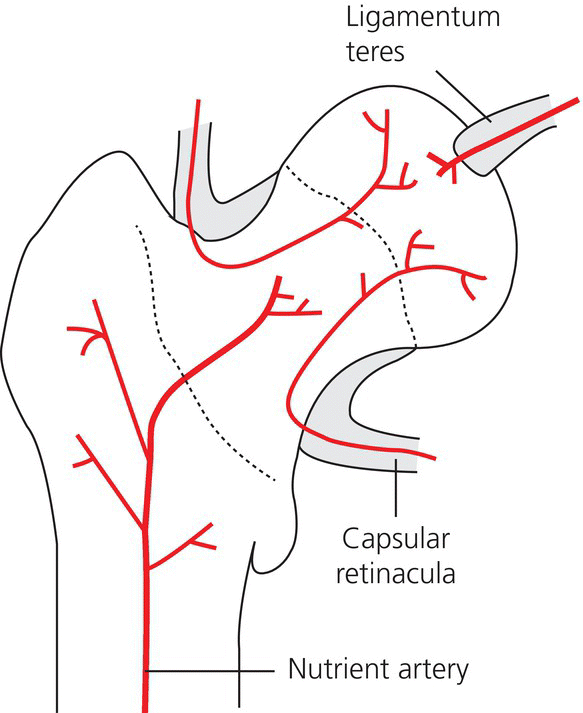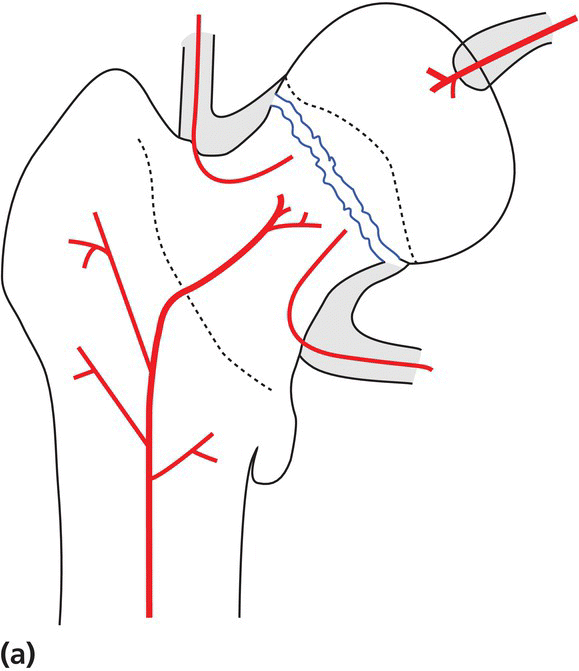Chapter 18
Fractures in the older person
Karen Hertz1 and Julie Santy-Tomlinson2
1 University Hospital of North Staffordshire, Stoke-on-Trent, UK
2 University of Hull, Hull, UK
Introduction
As the world’s population ages, musculoskeletal trauma in the older person presents a growing challenge to healthcare systems. Although management of older people following trauma needs to follow the general considerations described in Chapter 17, there are also some differences and specific considerations which must be taken into account when caring for the older patient.
There are several different mechanisms of injury of trauma in older people including many of those to which younger patients are subjected. The most common cause of injury in older people, however, is a fall and it will be fall-related trauma which is the focus of this chapter. The care of older trauma patients requires highly skilled, specialised care whatever the cause. The practitioner also needs to be aware of the issues surrounding patients being admitted as a result of elder abuse and ensure that local policies for reporting are followed in order to protect vulnerable older people from further harm (see Chapter 1).
The global development of orthogeriatric models of care, particularly in the management of patients with a hip fracture, has become a key feature of improvements in care delivery over the last few decades. This chapter aims to provide an overview of evidence-based fracture management, care and rehabilitation for older people, focusing specifically on fragility fractures. The intention is to assist the practitioner in providing skilled, high quality, age-sensitive care. Such care must consider the specific needs of older people and minimise the complications of injury, hospitalisation and surgery whilst facilitating the restoration of functional ability.
Fragility fracture
Older people with fractures normally present as a result of a fragility fracture. It is estimated that there is one fragility fracture worldwide every three seconds, equating to 25 000 per day (International Osteoporosis Foundation 2012). Almost all result in attendance at an emergency department (ED), admission to hospital or a general practitioner visit. ‘Fragility’ fracture is defined as a fracture that results from ‘low energy’ trauma and is caused by mechanical forces that would not ordinarily result in a fracture. The World Health Organization (WHO) has noted that the injury results from a fall from a standing height or less affecting an older person with osteoporosis or osteopoenia (Kanis et al., 2001). Osteoporosis is a chronic disease that weakens bone strength and is characterised by low bone mass and structural deterioration of bone tissue, with a consequent increase in bone fragility leading to susceptibility to fracture (Chapter 13). The onset is often asymptomatic and may only be recognised after a person falls and sustains a fracture. The annual numbers of fragility fractures in most developed countries are very high and considered to be a major challenge for health services. According to the National Osteoporosis Society almost half of all women and one in six men will experience an osteoporotic fracture during their lifetime. It is expected that incidence will continue to increase as the population ages. Osteoporosis already affects one in three women and one in 12 men aged over 50, particularly post-menopausal women. The incidence in both sexes is known to rise rapidly with age due to increased bone loss after the menopause in women and age-related bone loss in both women and men. The prevalence of osteoporosis increases markedly with age: from 2% at 50 years to more than 25% at 80 years in women. As the longevity of the population increases, so will the incidence of osteoporosis and associated fragility fractures (NICE, 2012). Individuals may have a life expectancy of up to forty years after their first fragility fracture potentially resulting in a need for long-term management of the issues and associated risks.
Fragility fractures occur most commonly in the spine (vertebrae), hip (proximal femur) and wrist (distal radius) and less often in the arm (humerus), pelvis, ribs and other bones. They result in significant pain and severe disability, often leading to a reduced quality of life. Hip and vertebral fractures are also associated with decreased life expectancy. Every fragility fracture signals an increased risk of future fractures – at least doubling the risk of further fractures as well as risk of premature mortality. Figure 18.1 demonstrates how the progress of osteoporotic fractures occurs across the lifetime. At its worst, the individual’s experience of osteoporosis can be one of remorseless progression: from Colles’ fracture and minor (and perhaps minimally symptomatic) vertebral fractures to the major distress, dependency and disability of hip fracture.

Figure 18.1 Fracture morbidity. Adapted from BOA/BGS 2007 with permission
The usual care people receive after fragility fracture can be inadequate. There is frequently a failure to recognise osteoporosis as the cause of the fracture and to initiate long-term management of the condition. Problems with coordinating the key elements of care including: case-finding those at high risk; providing falls prevention; bone protection; fracture surgery and rehabilitation, can result in sub-optimal care and associated poor outcomes for patients. Recent thinking, however, acknowledges that ‘optimal care is cheaper than suboptimal care’ (DOH, 2009) on the basis that better care results in better outcomes as well as reduced complications and length of stay with a greater chance of return to independent living. Focusing on high quality, optimal care is, therefore, an essential aim of service/practice development.
Several studies have shown that a previous fracture at any site is associated with a doubling of risk of further fracture (McLellan et al., 2004, Kanis et al., 2004) highlighting the need to identify (or ‘case-find’) those who have sustained such a fracture in order to initiate early clinical assessment, investigation and treatment. For patients aged over 50 proactive case-finding in acute hospitals by fracture liaison services involves identification, by a specialist practitioner, of any patients presenting with a fragility fracture either through emergency care, fracture clinics or orthopaedic wards or by identification of vertebral fractures on X-rays performed for the specific purpose or other reasons. The following steps are recommended:
- investigate bone density
- commence drug treatment according to national guidelines/local policy (Chapter 13)
- referral to falls services
- monitor and support medication compliance.
As many as half of post-menopausal women who have had a prior fragility fracture, will go on to sustain a hip fracture. Targeting these at risk groups in primary care and through fracture liaison in acute services provides ready access to those at greatest risk of hip fractures and offers some chance of reducing the numbers of fractures in the future and treatment reduces the fracture risk by 50% (DoH 2009).
Caring for older patients following trauma
Looking after older people following trauma must follow the same principles for trauma management for all age groups as discussed in Chapter 16. It must be recognised, however, that the normal and abnormal changes that occur with ageing, relating to anatomy and physiology, and compounded by past medical history and active co-morbidities, mean that mortality increases in older people as a result of morbidity and that the normal physiological responses will be different to those of a younger adult. Specific considerations relating to ageing include:
- Airway – ageing can cause degeneration of the physiological airway and musculoskeletal pathology such as osteoarthritis. It can also reduce neck and spine flexibility, making airway management difficult.
- Breathing – loss of respiratory resilience, particularly with chronic obstructive pulmonary disease, means that patients can hypoventilate when supplemental oxygen is considered. They still need oxygen therapy, but require closer monitoring in recognition of this. Older people are also more at risk of respiratory failure because of the increased work of breathing.
- Circulation – reduction in cardiopulmonary reserve means that there is an increased risk of fluid overload when administering intravenous fluids (particularly colloids), requiring closer monitoring. Normal heart rate and blood pressure are not a guarantee of normal cardiac output and the use of beta blockers and anti-hypertensive agents can mask the signs of deterioration. In the event of cardiac arrest, beta blockers and antiplatelet medications will negatively influence outcome.
- Disability – prolonged inactivity and disuse often limits ultimate functional outcome and impacts on survival.
- Exposure – skin and connective tissue undergo extensive changes in the ageing process, resulting in diminished thermoregulation, increased risk of infection, poor wound healing and increased susceptibility to hypothermia.
It is important to consider older people following trauma as individuals and make sure that a full and comprehensive history is obtained that includes relevant co-morbidities and medication history along with an overview of previous functional ability and personal and social history. Assessment and subsequent care is best provided and managed by effective teams working to sound orthogeriatric principles. These include treating the fracture while considering the causes of the fall and any unstable co-morbidities as well as initiating effective rehabilitation while assessing and treating bone health with the aim of preventing further fractures. Over the last few years, hospital mortality has reduced in care settings where orthogeriatric input is available. In addition to the principles of fracture management described in Chapter 17, there are a number of specific considerations when managing fractures in older people. Osteoporosis, for example, not only makes fracture more likely, it also means that fractures are more likely to be comminuted – making anatomical reduction of the fracture problematic. The condition slows fracture healing and makes achieving sound internal fixation more difficult, meaning that fixation needs to be more robust and durable.
Hip fracture
Hip fracture is the plain English term for a proximal femoral fracture (or PFF). It refers to a fracture occurring in the area between the edge of the femoral head and 5 cm below the lesser trochanter (Figure 18.2). Such fractures are mostly fragility fractures occurring in older people. Half of all patients admitted with a hip fracture have had a previous fragility fracture – a ‘signal’ fracture that gives health care providers the opportunity to commence treatment to reduce the likelihood of hip fracture occurring. It is important to stress that identifying those patients at risk of this is central to decreasing the number of patients sustaining a hip fracture in the future.

Figure 18.2 Classification of hip fracture. From Parker and Johanssen 2006 with permission
Hip fracture is the commonest reason for admission to an orthopaedic unit, accounting for more than 20% of orthopaedic bed occupancy. In women over 45 years hip fractures can account for a higher proportion of hospital bed occupancy than other common conditions (DoH 2009), making the injury a major challenge as a common serious injury which is predominantly a phenomenon of later life. The average age of a person with a hip fracture is 83 years for men and 84 years for women. In the UK, for example, about 70–75 000 hip fractures occur annually and the total annual cost (including medical and social care) for all UK cases is estimated to be about £2 billion (NHFD, 2010). A similar picture is reported in many other developed nations such as Australia, Canada and Sweden (Kanis et al., 2012) although statistics suggest that rates are beginning to decline in some areas (Leslie et al., 2009, Pasco et al., 2011). The majority of expenditure is accounted for by hospital bed days and by health and social aftercare costs. It is predicted that by 2020 the number of people experiencing hip fracture in the UK will be in the region of 101 000 (BOA/BGS 2007).
For many previously fit patients, sustaining a hip fracture means loss of mobility and, for some of the frailer patients, the permanent loss of their ability to live at home. At present about a quarter of patients admitted to hospital following hip fracture come from institutional care and around 10–20% of those admitted from home ultimately move to institutional care.
It is widely documented that mortality at one year following hip fracture is approximately 30% (Parker and Anand 1991, SIGN 2009, BOA/BGS 2007). However, fewer than half of deaths are attributable to the fracture itself, reflecting the frailty of the patients and associated high prevalence of co-morbidities and complications. It is often the occurrence of a fall and consequent fracture that signals underlying ill health. Hence, hip fracture is by no means an exclusively surgical concern. Its effective management requires the coordinated application of nursing, medical, surgical, anaesthetic and multidisciplinary rehabilitation skills and a comprehensive approach covering the entire journey from emergency care to discharge. Increasingly the approach of an orthogeriatric model has been adopted in caring for patients following hip fracture – demonstrating significant improvements in care and patient outcomes along with reduced mortality.
Diagnosis
Patients with a hip fracture typically present to emergency services unable to walk and may exhibit shortening and external rotation of the affected limb. Frequently, but not exclusively, they give a history of trauma and have hip pain. In some instances patients may complain only of vague pain in their buttocks, knees, thighs, groin or back and their ability to walk may be unaffected. The majority of hip fractures are easily identified using plain X-rays, but an apparently normal X-ray does not necessarily exclude a fractured hip. Where there is doubt regarding the diagnosis (for example, a radiologically normal hip X-ray in a patient who remains symptomatic) and where the radiographs have been reviewed by a radiologist, alternative imaging should be performed. Magnetic resonance imaging (MRI) should be offered where hip fracture is suspected despite negative anteroposterior pelvis and lateral hip X-rays. If MRI is not available within 24 hours, or is contraindicated, computed tomography (CT) should be undertaken (NICE 2011).
Management
Surgical intervention is the treatment of choice for almost all patients following hip fracture. Exceptions are those in whom the fracture is already healing in a satisfactory alignment and those whose expected survival is, for reasons unrelated to hip fracture, very short. The NHFD report (2012) identified that less than 3% of patients did not have surgery. The timing of surgery has been shown to be important and this is discussed in Box 18.1.
Box 18.1 Evidence digest:
Hip fractures are divided into two main groups depending on their relationship to the capsule of the hip joint (Figures 18.2 and 18.3). Those within the joint capsule are termed intracapsular or femoral neck fractures. Those below the insertion are extracapsular. The extracapsular group is then further sub-classified into trochanteric and subtrochanteric fractures. There is a practical basis to the division into intracapsular and extracapsular fractures relating to both the blood supply of the femoral head and the mechanics of fixation (Figures 18.3 and 18.4a and b). It is, therefore, inaccurate to classify all hip fractures as fractures of the neck of the femur as this region is involved only in some fractures and the terminology should be used carefully to avoid confusion, since the classification has a significant impact on the treatment and care required. The recommended surgical procedure for the different fracture groups is as follows:

Figure 18.3 The blood supply to the head and neck of femur


Figure 18.4 a and b Examples of disruption of the blood supply to the head and neck of femur following fracture a) Minimal disruption of the blood supply following extracapsular fracture e.g. intertrochanteric fracture, and b) Significant disruption of the blood supply following intracapsular fracture e.g. subcapital fracture
Undisplaced intracapsular fractures
Surgical treatment is almost mandatory. Some impacted fractures may be difficult to diagnose but prognosis for impacted or undisplaced fractures is good following internal fixation conducted with a widely used method that is familiar to the surgeon such as cancellous bone screws (Mak et al., 2010).
Displaced intracapsular fractures
Surgical treatment is almost mandatory for displaced intracapsular fractures as they will not unite without fixation or replacement. Replacement arthroplasty is used in patients with a displaced intracapsular fracture (e.g. hemi-arthroplasty or total hip replacement) because of the risk of avascular necrosis of the femoral head as a result of disruption to local blood supply resulting from displacement of the fracture. The femoral head derives its blood supply from three sources (Figures 18.3 and 18.4): the nutrient artery and vessels from the joint capsule and the ligament teres. When the femoral head is displaced the blood supply from all but the ligament teres is disrupted and this may be severe enough to cause ischaemia, resulting in bone death (avascular necrosis) and subsequent collapse of the femoral head. This leads to destruction of the joint, causing ongoing pain and deformity. Hemi-arthroplasty (Figure 18.5) is commonly performed for displaced intra-capsular fractures. Compared to uncemented arthroplasty, cemented arthroplasty is said to improve hip function and is associated with lower residual pain post-operatively. Blood loss from an intracapsular fracture at the time of injury is minimal because of the poor vascular supply at the fracture site (AAGBI 2011).

Figure 18.5 Hemiarthroplasty. Reproduced with permission from Mr Philip John Roberts
There is an increasing body of evidence to support total hip replacement (THR) over hemi-arthroplasty in selected patients (Figure 18.6). This is recommended by NICE (2011) who suggest that total hip replacements are offered to patients with a displaced intracapsular fracture who prior to the fracture:
- were able to walk independently and
- are not cognitively impaired and
- are medically fit for anaesthesia and the procedure.





